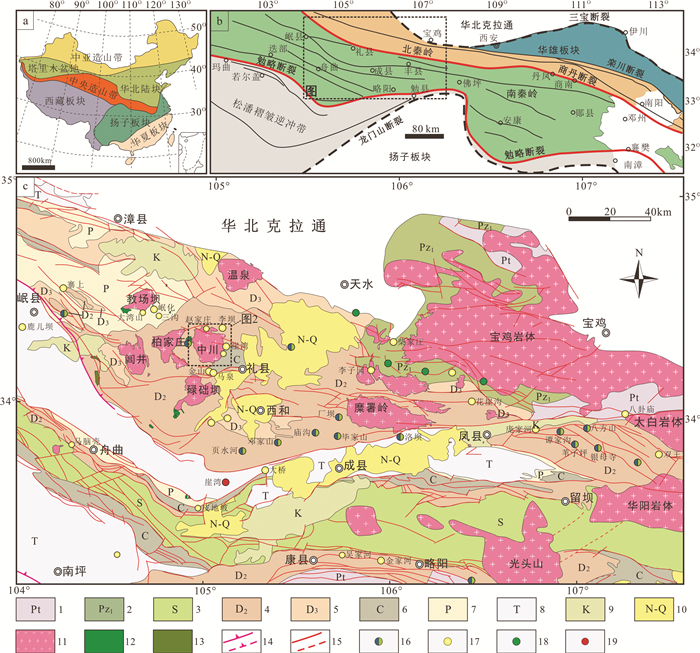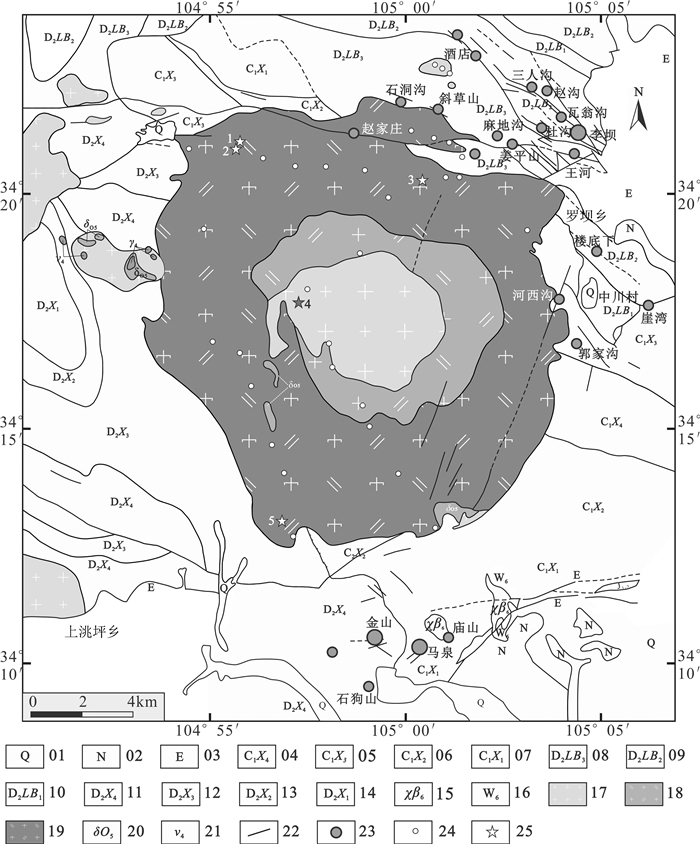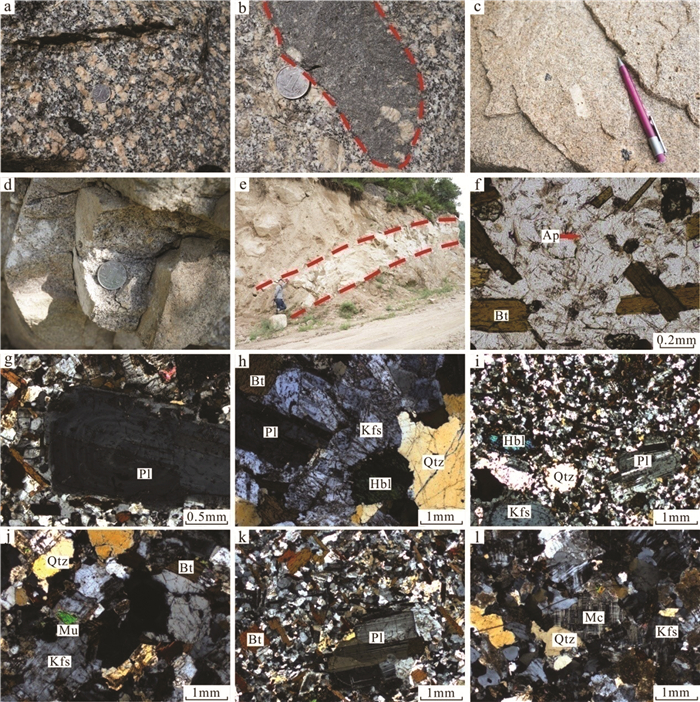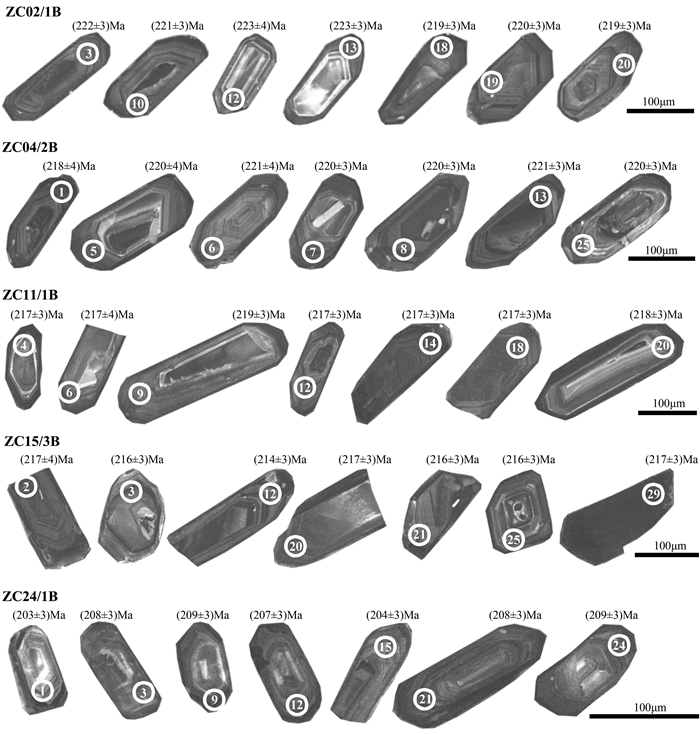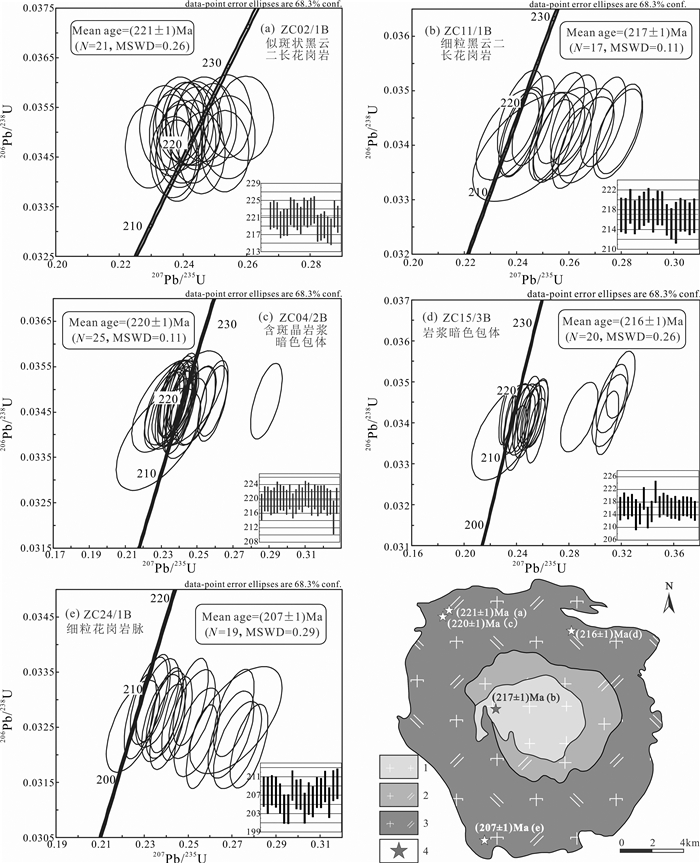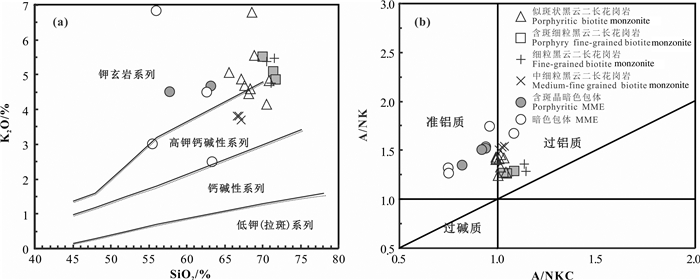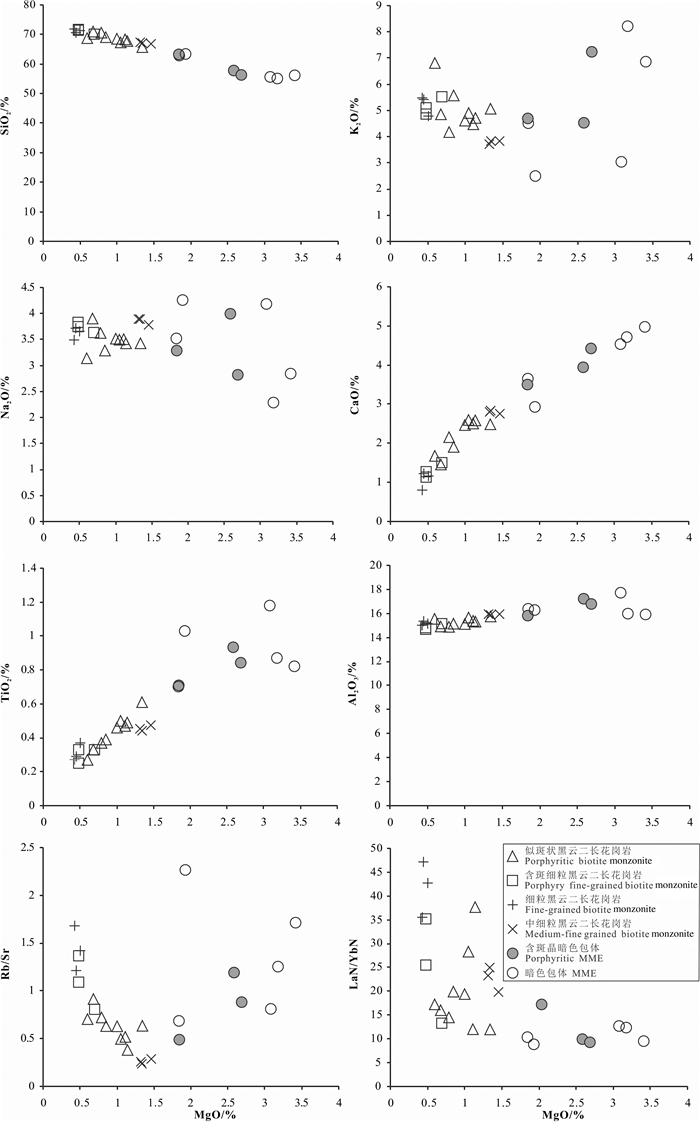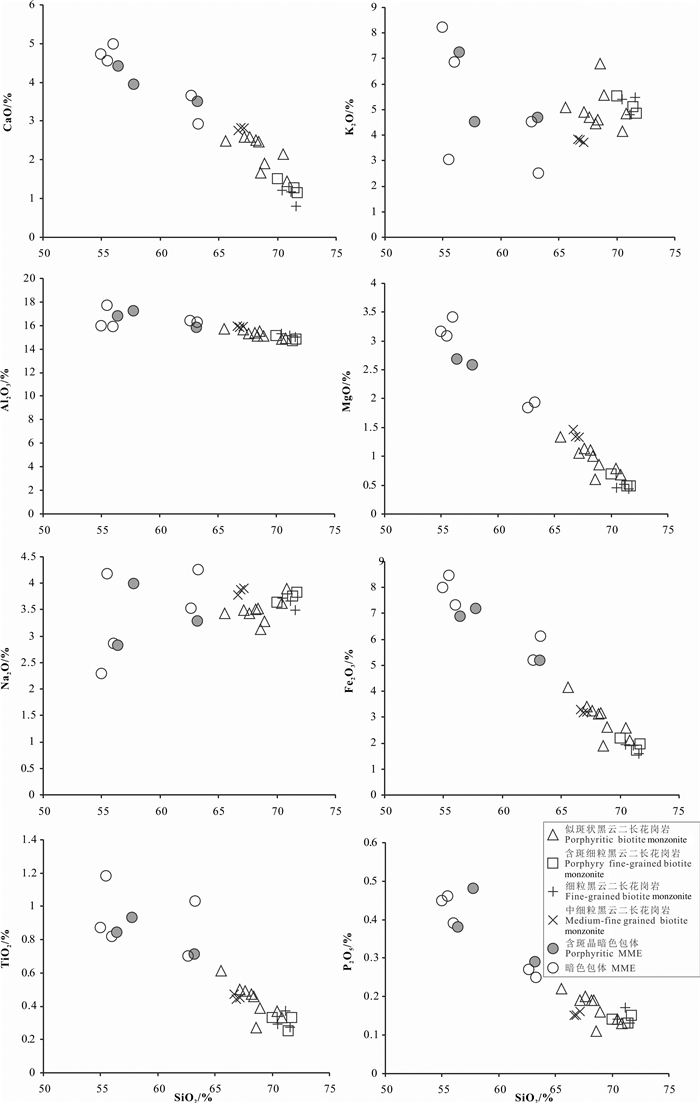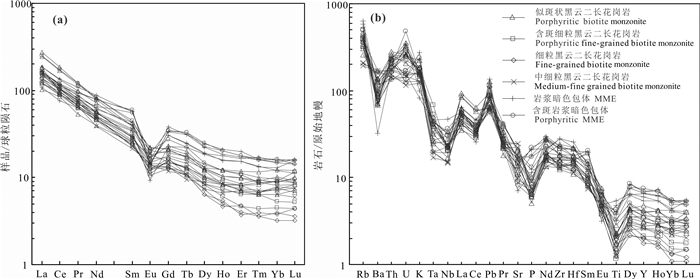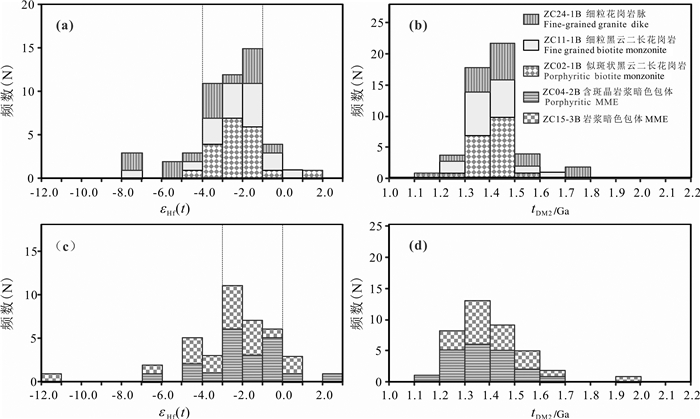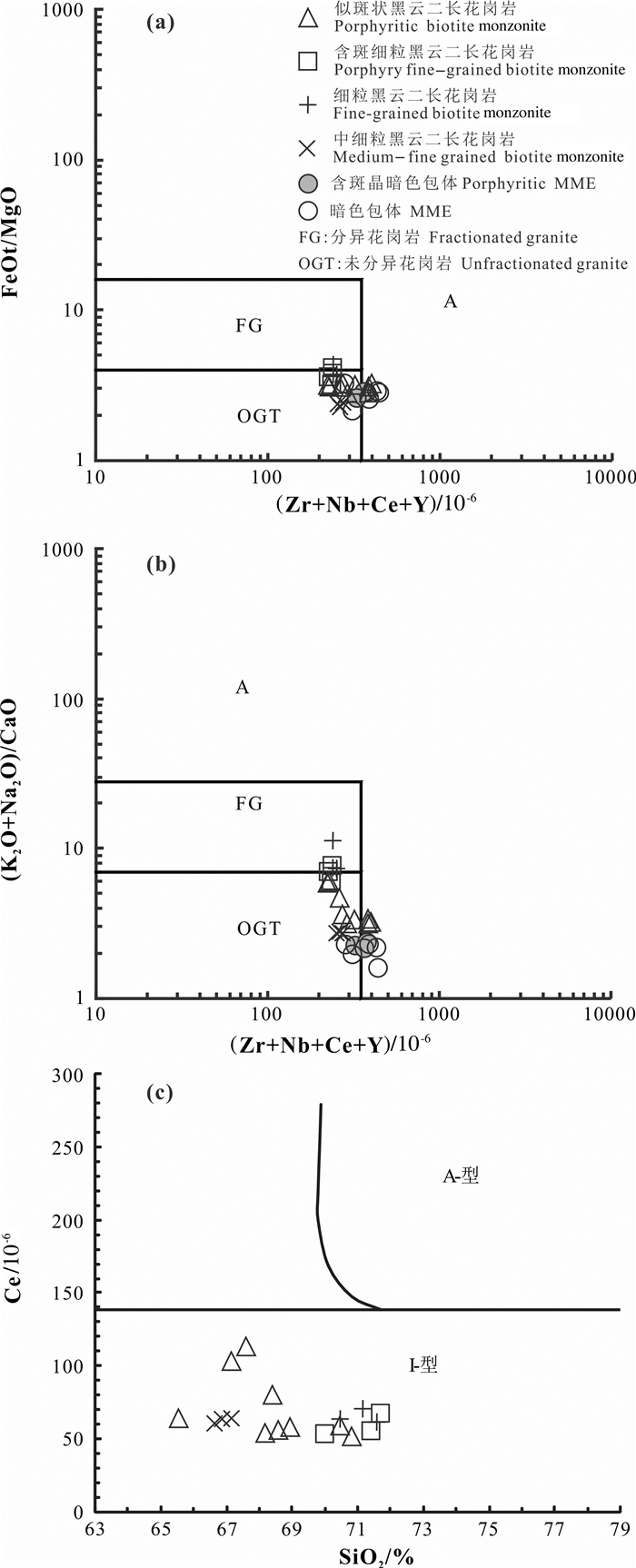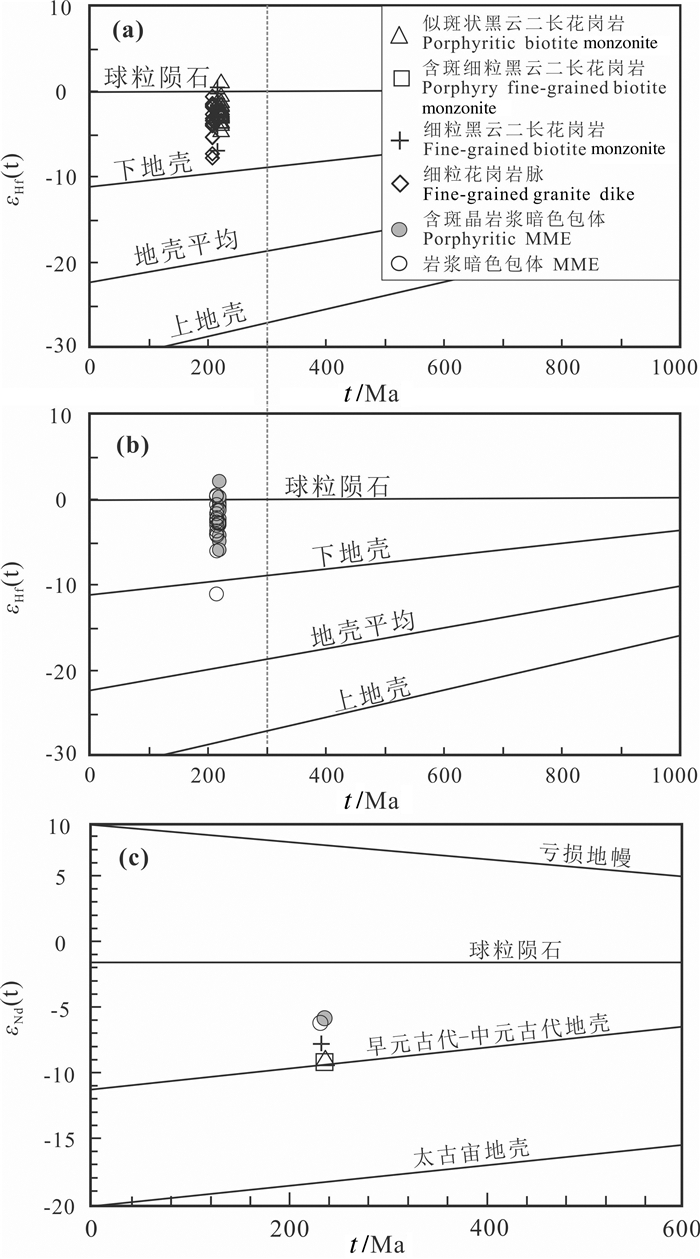Age, geochemistry, Nd-Hf isotopes and relationship between granite and gold mineralization of Zhongchuan granitoid pluton in West Qinling
-
摘要:
中川岩体位于秦岭造山带西段,岩体呈同心环状产出,由外向内岩性依次为似斑状黑云二长花岗岩→含斑黑云二长花岗岩→中细粒黑云二长花岗岩,岩体边部发育岩浆暗色包体,向内逐渐减少。LA-ICPMS锆石U-Pb定年结果显示,似斑状黑云二长花岗岩、含斑角闪黑云石英闪长岩(岩浆暗色包体)、细粒黑云二长花岗岩、岩浆暗色包体(无斑)和细粒花岗岩脉的年龄分别为:(221±1)Ma(MSDW=0.26)、(220±1)Ma(MSDW=0.11)、(217±1)Ma(MSDW=0.11)、(216±1)Ma(MSDW=0.26)、(207±1)Ma(MSDW=0.29),表明岩体从边部到中心年龄逐渐变新。寄主岩石与暗色包体的里特曼指数和A/CNK值分别为2.20~3.85、0.99~1.15和2.24~9.22、0.75~1.08,两者分别为准铝质-弱过铝质、高钾钙碱系列和钾玄岩-高钾钙碱系列;稀土元素和微量元素均显示出富集LREE、Rb、Ba、K等大离子亲石元素,亏损HREE、Zr、Hf、Ta、Nb、P、Ti等高场强元素的特征,具有弱的负铕异常(δEu=0.29~0.91),无Ce异常,寄主岩显示出I型花岗岩的特征,并且中心部位的细粒黑云二长花岗岩具高分异I型花岗岩的一些特征。在哈克图解上暗色包体和寄主岩石的主要氧化物具有良好的线性关系;在同位素组成上,寄主岩石与暗色包体的εNd(t)分别变化于-7.31~-8.73和-5.32~-5.69,TDM2分别变化于1.59~1.71 Ga和1.43~1.46 Ga,εHf(t)值分别为-7.02~-0.31和-3.0~0,TDM2为1.27~1.70 Ga和1.2~1.5 Ga,显示寄主花岗岩和岩浆暗色包体分别来源于不同源区,寄主岩石主要是古老地壳物质部分熔融的结果,岩浆暗色包体可能是来自岩石圈地幔,但与寄主花岗质岩浆已发生了一定程度的混合作用。岩体外围金矿床形成略晚于岩体,与花岗质脉岩年龄相近,空间上与岩体密切相关,结合前人成矿物质来源的研究,认为成矿物质与成岩物质具有相似性。表明该岩体与其周围的金矿具有成因联系,岩浆作用不仅提供了热能,也有物质贡献。
Abstract:The Zhongchuan granitoid pluton is located in the east of the Western Qinling. Zircon LA-ICPMS dating for the porphyritic monzogranite from the Zhongchuan pluton yielded an age of (221±1)Ma (MSWD=0.26), the age of fine-grained monzogranite is (217±1)Ma(MSWD=0.107), that of magmatic enclave include phenocryst is (220±1)Ma(MSWD=0.107), that of magmatic enclave is (216±1)Ma (MSWD=0.26) and that of fine-grained granite vein is 207±1Ma(MSDW=0.29). Magmatic enclave and rock mass have the same age, and the age of granite vein is the youngest, indicating that the ages gradually become younger from the edge to the center. The rock mass and magmatic enclave are respectively of meta-aluminous or weakly peraluminous, high-K calc-alkaline and high-K calc-alkaline or shoshonite series with the Litman index(σ) being 2.20-3.85, 2.24-9.22 and A/CNK being 0.99-1.15, 0.75-1.08. Their REE and trace elements are enriched in large ion lithophile elements (LREE, Rb, Ba, K) and depleted in high-field strength elements(HREE, Zr, Hf, Ta, Nb, P, Ti), with slightly negative to positive anomalies of Eu (δEu=0.29-0.91) and no anomalies of Ce. These characteristics suggest that the granitoids have I type granite features, and the fine-grained monzogranite is located in the center with some highly fractionated I type granite features. The main oxides of rock mass and MME have a good linear relationship in Harker diagram. Nd isotopic compositions of the rock mass and MME are mainly characterized by εNd(t) values of -7.31--8.73 and-5.32--5.69, and TDM2 of 1.59-1.71 Ga and 1.43-1.46 Ga. Zircon Hf isotopic compositions of the rock mass and MME are mainly characterized by εHf(t) values of-7.02--0.31 and -3.0-0, TDM2 of 1.27-1.70 Ga and 1.2-1.5 Ga. These characteristics suggest that the rock mass was derived from partial melting of ancient crustal material and magmatic enclave was derived from the lithospheric mantle, with some mixture. The formation of gold deposits was closely related to Zhongchuan granitoid pluton in time and space, and the age of the gold deposit are slightly later than that of Zhongchuan granitoid pluton and close to that of granite vein. Mineralization data indicate that ore-forming material and lithogenous material were similar to each other. These data indicate that magmatism not only provided a thermal source for the mineralization but also offered ore-forming material.
-
Keywords:
- Zhongchuan pluton /
- zircon U-Pb age /
- Nd-Hf isotope /
- granite /
- geological survey engineering /
- West Qinling
-
1. 引言
南美洲以铜、铁、锂、金、银等闻名于世(陈玉明等,2017)。其铁矿类型多样、资源丰富,在全球铁矿成矿规律研究、资源开发和贸易中占有举足轻重的地位。该洲铁矿床主要类型有沉积-变质型和火山成因型铁矿,主要分布于委内瑞拉的玻利瓦尔州,巴西的阿马帕州、帕拉州、米纳斯吉拉斯州、北里奥格兰德州、巴拉伊巴州、巴伊亚州、南马托格罗索州,玻利维亚的圣克鲁斯州,秘鲁的伊卡-阿雷基帕海岸带和智利的卡拉马-圣地亚哥海岸带等(郭维民等,2013;曾勇等,2015;方维萱等,2014;姚春彦等,2014;陈玉明等, 2017, 待出版)。南美洲已成为中国第二大铁矿石来源地,目前年进口铁矿石量超过2.2亿t,主要进口于巴西、秘鲁、委内瑞拉等国(中国海关信息网,2017)。
近10年来,中国地质调查局在南美洲开展了多项国际合作项目,系统收集、积累了大量南美洲地质矿产资料,是“全球地质矿产信息系统”的重要组成部分。国内外学者虽对南美洲铁矿床开展过一些研究,多集中于典型铁矿床成岩成矿年代学、矿床成因,重要成矿带铁矿成矿规律等研究(郭维民等,2013;曾勇等,2015;方维萱等,2014;姚春彦等,2014),而对南美洲不同成因类型的铁矿床时空分布规律尚缺系统的总结和梳理。为此,本文依托“全球矿产资源信息系统”,通过对收集的南美洲铁矿地质资料的整理和综合研究,首次系统分析总结了南美洲铁矿资源及禀赋特征、区域成矿背景、主要矿床类型,圈出铁矿重要成矿区带10个,并采用统计分析方法研究了铁矿的时空分布规律,对全面了解认识南美洲铁矿地质特征、成矿规律和指导找矿提供参考。
2. 南美洲铁矿资源、禀赋特征
2.1 铁矿资源概述
南美洲铁矿资源丰富,根据美国地质调查局(USGS 2017年)公布的数据,该洲铁矿石储量(系经过可行性及预可行性研究,并对经济、开采、选冶、环境、法律、市场、社会和政府等因素进行了修改后表明在当时是经济的和可开发利用的那部分资源量)超过300亿t,占世界铁矿石总储量(1700亿t)的17.6%以上。南美洲铁矿资源主要分布在巴西、玻利维亚、委内瑞拉、智利、秘鲁等国。其中,巴西铁矿资源量(系指查明的铁矿资源的一部分和潜在资源的总和,包括经可行或预可行性研究证实为次边界经济的铁矿资源及经过勘查而未进行可行或预可行性研究的内蕴经济的铁矿资源,以及经过预查后预测的资源)927亿(t SNL数据库),约占南美洲铁矿资源量的53.68%,全球铁矿资源量的11.33%;玻利维亚铁矿资源量为402.9亿(t SNL数据库),在南美洲位列第二,占全球铁矿资源总量的4.93%(表 1)。
表 1 南美洲各国铁矿资源概况Table 1. Summary of iron ore resources in South America
南美洲是全球铁矿勘查开发的热点地区之一,特别是巴西,在2008年以前一直是全球最大的铁矿石生产国(从2008年澳大利亚铁矿石产量开始超过巴西)。2016年南美洲铁矿石年产量在4.5亿t,占全球总产量的1/5强,铁矿石出口量约3.7亿t,占全球铁矿石出口贸易量的1/4强(陈玉明等,2017)(表 1)。
在南美洲铁矿资源处于第二位的玻利维亚,由于身处内陆,缺少出海口,加之国内基础设施薄弱,铁矿资源还处于未开发阶段;委内瑞拉、秘鲁和智利尽管铁矿资源也都很丰富,从每年的产量看,开发潜力巨大。
2.2 铁矿资源禀赋特征
南美洲铁矿资源丰富,是全球重要的铁矿石生产和销售地,在世界铁矿石贸易中占有重要地位,其铁矿资源禀赋特征如下:
(1) 铁矿类型较齐全,沉积-变质型是最重要类型南美洲铁矿类型较齐全,已发现的铁矿床类型在南美洲均有发现。铁矿资源84%来自沉积-变质型,15%来自火山成因型(我国典型的是产于南京-芜湖地区的中生代陆相火山岩的玢岩型铁矿,国外典型的有形成于古元古代的瑞典基鲁纳(Kiruna)铁矿及形成于上新世-早更新世的智利埃尔拉科(El.laco)铁矿),5%来自接触交代-热液型(矽卡岩型),沉积型鲕状赤铁矿(少量)属难选冶类型,本区并未开发(陈玉明等, 2017, 待出版)。
(2) 铁矿分布广泛集中
南美洲铁矿资源也与其他地区一样,分布相对集中,具有分布不均匀性。从大地构造环境看:主要分布在南美地台的地盾区(董永观等,2013;Zappettini et al., 2005;Cordani,2000),其次是安第斯造山带海岸科迪勒拉中段的秘鲁中南部-智利北部(方维萱等,2014;肖荣,2013;席振,2011;Sillitoe. 2003)。从地理位置看,主要分布在巴西的米纳斯吉拉斯州、帕拉州、北里奥格兰德州、巴伊亚州等,委内瑞拉的玻利瓦尔州,玻利维亚的圣克鲁斯州,秘鲁的伊卡-阿雷基帕海岸带,智利的卡拉马-圣地亚哥海岸带等。
(3) 铁矿数量多,大型、超大型矿区资源量占主导地位
根据SNL数据库资料统计,南美已发现具有一定规模的铁矿床(点)255处,其中超大型(>10亿t)矿床有36处,大型(>1亿t,<10亿t)63处,中小型(<1亿t)157处。大型、超大型铁矿数量不仅多,占总发现数的38.7%,其资源量更占总量的99.33%,而中小型矿区资源量仅占总量的0.67%。
(4) 铁矿石品位高,多数矿石可直接入炉或易选
南美洲铁矿床大部分是赤铁矿,系前寒武纪含铁建造在地质演化过程中遭受表生氧化和风化淋滤作用而形成的(在风化作用下,脉石组分部分或全部溶解和带走,金属矿物部分或全部转变成针铁矿或赤铁矿,伴随淋滤作用,下渗的地表水溶解并带走二氧化硅,使铁残留富集而成)(沈承珩等,1995)。铁品位高,平均为62%,加工后成品粉矿品位一般为65%~66%,块矿品位一般为64%~67%,有害杂质少,属可直接入炉的高品位矿石;而磁铁矿矿石一般铁品位也在45%~60%,易于采用磁选+浮选获得高品位(>66%)铁精粉。
(5) 部分铁矿伴生有益组分较多,综合回收利用潜力大
南美安第斯造山带海岸科迪勒拉中段的秘鲁中南部-智利北部的火山成因型铁矿床中常含有铜、金、铅锌、钴等伴生有益组分(方维萱等,2014;尚潞军等,2017;Sillitoe et al., 2003),地盾区的沉积-变质型铁矿中,锰、金、铜等元素含量也都较高(曾勇等,2013, 2015;郭维民等,2013;姚春彦等,2014;Monteiro, 2008a, b),一些学者将该类型铁矿还称为铁氧化物性铜、金矿床(IOCG型)(方维萱等,2014;曾勇等, 2013, 2015),其综合回收利用潜力巨大。
3. 区域成矿地质背景和主要矿床类型
3.1 区域成矿地质背景
南美洲地处冈瓦纳成矿域与环太平洋成矿域交汇部位,位于冈瓦纳成矿域西部的南美地台成矿区,成矿地质构造背景以前寒武系地块及叠加其上的显生宙沉积盆地和构造带占绝对优势(董永观等,2013;Zappettini et al., 2005;Cordani et al., 2000),而位于环太平洋成矿域东环南段的安第斯成矿区,成矿地质构造背景主要是显生宙造山带,成矿时代以中新生代占绝对优势❶(卢民杰等,2016)。在这两种截然不同的成矿构造背景下形成了丰富的铁矿资源(图 1)。
![]() 图 1 南美地质构造分区略图(据Cordani et al. 2000)AM-亚马孙克拉通;SF-圣弗朗西斯科克拉通;RP-拉普拉塔克拉通;SL-圣路易斯克拉通残片;LA-路易斯阿尔维斯克拉通残片; T-托坎廷斯造山带;B-博博尔马造山带;M-曼蒂凯拉造山带Figure 1. Sketch map of division of tectonics in South America (after Cordani et al., 2000)AM-Amazonian craton; SF-Sao Francisco craton; RP-Rio de la Plata craton; SL-Sao Luis cratonic fragment; LA-Luis Alves cratonnic fragment; T-Tocantins orogenic belt; B-Borborma orogenic belt; MMantigueira orogenic belt
图 1 南美地质构造分区略图(据Cordani et al. 2000)AM-亚马孙克拉通;SF-圣弗朗西斯科克拉通;RP-拉普拉塔克拉通;SL-圣路易斯克拉通残片;LA-路易斯阿尔维斯克拉通残片; T-托坎廷斯造山带;B-博博尔马造山带;M-曼蒂凯拉造山带Figure 1. Sketch map of division of tectonics in South America (after Cordani et al., 2000)AM-Amazonian craton; SF-Sao Francisco craton; RP-Rio de la Plata craton; SL-Sao Luis cratonic fragment; LA-Luis Alves cratonnic fragment; T-Tocantins orogenic belt; B-Borborma orogenic belt; MMantigueira orogenic belt3.1.1 南美地台区铁矿成矿地质背景
南美地台主要由亚马孙、圣弗朗西斯科、拉普拉塔克拉通等及小的克拉通残片(或陆核)组成(Zappettini et al,2005;Cordani et a.l,2000),总体表现为“三盾三盆”。“三盾”即圭亚那地盾、中巴西地盾及大西洋地盾(又称圣弗朗西斯科地盾或巴西滨海地盾),圭亚那地盾和中巴西地盾两者基底是相连的,统称为亚马孙克拉通。“三盆”是指地盾之间发育有三个沉积盆地,即亚马孙盆地、巴尔纳伊巴盆地和巴拉纳盆地(图 1)。
南美地台的这些地体在新元古代末期,在巴西利亚一系列碰撞造山旋回作用下,才最终拼合,基本形成现今的南美地台(Cordani et al., 2000;Santos et al., 2003)。受构造碰撞、拼贴作用影响,克拉通之间或周边发育一系列构造活动带(如中巴西地盾上的托坎廷斯造山带(Tocantins),大西洋地盾上的博博尔马造山带(Borborma)和曼蒂凯拉造山带(Mantigueira))。这些多期次复杂的构造岩浆活动为该区众多大型超大型铁矿的形成创造了条件。
3.1.2 安第斯带铁矿成矿地质背景
安第斯成矿带是环太平洋成矿域的组成部分,位于环太平洋成矿域的东南部,呈S-N向展布于南美洲大陆西缘(图 1)。其成矿作用和成矿构造环境主要与太平洋板块向南美板块的俯冲碰撞有关,为中-新生代活动陆缘增生造山带(卢民杰等,2016)。
安第斯带铁矿床主要分布在中安第斯岩浆弧-弧后盆地,盆地内充填的是侏罗纪和早白垩世的火山沉积物及海-陆相沉积物,矿体受区内拉张环境下形成的与海沟近平行的深大断裂控制。
3.2 成因类型
南美洲铁矿床类型以分布在地盾区的沉积-变质型最为重要,约占铁矿总量的85.5%,其次是分布在秘鲁中南部到智利中部圣地亚哥地区的火山成因型铁矿床,约占10%;接触交代-热液型约占4.5%,此外还有少量的海相沉积型铁矿床。
地盾区沉积-变质型铁矿按形成时代可以划分为3组:①古太古代(3.7~3.4 Ga),如圭亚那地盾伊玛塔卡杂岩体内的铁矿床(Zappettini et al., 2005;沈承珩,1995);②新太古代(2.8~2.5 Ga),如巴西米纳斯-吉拉斯和卡拉加斯地区(曾勇等,2013;郭维民等,2013;姚春彦等,2014;Monteiro et al., 2008a, b;沈承珩,1995);③新元古代,如巴西和玻利维亚交界处的穆通-乌鲁库姆地区的铁矿床(沈承珩,1995)。
与火山成因有关的铁矿床主要分布在从秘鲁中南部到智利中部的圣地亚哥长约2000 km的安第斯海岸带,主要矿床有秘鲁的马尔科纳铁矿、邦沟铁矿,智利的科罗拉多铁矿、罗梅拉尔铁矿等❷ (Chen et al., 2010a, b)。
4. 重要铁矿成矿区带及典型矿床(区)地质特征
4.1 重要铁矿成矿区带
在综合已知铁矿床(点)类型及分布特征、容矿岩体或火山-沉积岩展布特点、大地构造背景、铁矿成矿地质条件连续性、找矿标志分布特点、遥感、航磁、地球化学异常分布特点等,本文在南美洲共圈出10个重要铁矿成矿区带(图 2,表 2)。
![]() 图 2 南美洲重要铁成矿区带分布图1-委内瑞拉伊玛塔卡铁成矿区带;2-巴西阿马帕铁成矿区带;3-巴西卡拉加斯铁成矿区带;4-巴西北里奥格兰德-巴拉伊巴铁成矿区带;5-巴西巴伊亚中部铁成矿区带;6-巴西米纳斯吉拉斯州“铁四角”及邻区铁成矿区带;7-玻利维亚-巴西边界木通-乌鲁库姆铁成矿区带;8-秘鲁中南部安第斯海岸带铁成矿区带;9-秘鲁安第斯造山带中部铁成矿区带;10-智利中北部安第斯海岸带铁成矿区带Figure 2. Important metallogenic zones of iron in South America1-Imataka iron ore zone of Venezuela; 2-Amapa iron ore zone of Brazil; 3-Carajas iron ore zone of Brazil; 4-Rio Grande do Norte-Paraiba iron ore zone of Brazil; 5-Central of Bahia iron ore zone of Brazil; 6-QuadrilateroFerrifero and adjacent areas in Minas Gerais iron ore zone of Brazil; 7-El Mutun iron ore zone of Bolivia-Urucum iron ore zone of Brazil; 8-Andean Coastal iron ore zone of Central and southern in Peru; 9-Andean orogenic belt iron ore zone of Central in Peru; 10-Andean Coastal iron ore zone of Central and s North in Chile表 2 南美洲铁矿重要成矿区带Table 2. Major metallogenetic zones of iron in South America
图 2 南美洲重要铁成矿区带分布图1-委内瑞拉伊玛塔卡铁成矿区带;2-巴西阿马帕铁成矿区带;3-巴西卡拉加斯铁成矿区带;4-巴西北里奥格兰德-巴拉伊巴铁成矿区带;5-巴西巴伊亚中部铁成矿区带;6-巴西米纳斯吉拉斯州“铁四角”及邻区铁成矿区带;7-玻利维亚-巴西边界木通-乌鲁库姆铁成矿区带;8-秘鲁中南部安第斯海岸带铁成矿区带;9-秘鲁安第斯造山带中部铁成矿区带;10-智利中北部安第斯海岸带铁成矿区带Figure 2. Important metallogenic zones of iron in South America1-Imataka iron ore zone of Venezuela; 2-Amapa iron ore zone of Brazil; 3-Carajas iron ore zone of Brazil; 4-Rio Grande do Norte-Paraiba iron ore zone of Brazil; 5-Central of Bahia iron ore zone of Brazil; 6-QuadrilateroFerrifero and adjacent areas in Minas Gerais iron ore zone of Brazil; 7-El Mutun iron ore zone of Bolivia-Urucum iron ore zone of Brazil; 8-Andean Coastal iron ore zone of Central and southern in Peru; 9-Andean orogenic belt iron ore zone of Central in Peru; 10-Andean Coastal iron ore zone of Central and s North in Chile表 2 南美洲铁矿重要成矿区带Table 2. Major metallogenetic zones of iron in South America

4.2 典型矿床(区)地质特征
4.2.1 巴西铁四角铁矿区
铁四角矿区位于巴西东南部米纳斯吉拉斯州贝洛奥里藏特(Belo Horizonte)市南部,面积约15000 km2。因其在平面上大致呈四边形,且赋存有丰富的高品位铁矿石,所以最早被Dorr(1969)称为“铁四角”。区内发现的铁矿床有数十个,资源量达250亿t,是巴西最大的铁矿区之一。
4.2.1.1 大地构造背景
铁四角地区位于圣弗朗西斯科克拉通的南缘,其核部为克拉通,周围是巴西利亚旋回(0.8~0.6 Ga)形成的造山带。该区构造演化复杂,至少遭受古元古代的泛亚马逊运动(2.1~2.0 Ga)和新元古代-早古生代的巴西利亚-泛非运动(0.65~0.50 Ga)两次造山作用的影响:泛亚马逊造山早期使该区形成NE-SW走向的褶皱,之后又叠加了近NW-SE向的构造,形成大规模走滑、逆冲断裂及褶皱;太古宙花岗质刚性地体在泛亚马逊造山时期没有受到褶皱作用的影响,但经历了再活化作用,有年轻的花岗岩体侵入,形成穹隆构造;巴西利亚造山作用在区域上主要发育逆冲、走滑断裂构造,其次为紧闭、等倾褶皱和韧性剪切带,并对古老的大型向斜构造进行改造。
4.2.1.2 区域地质
铁四角地区出露的地层主要是克拉通结晶基底,包括太古宙中-高级变质地体及花岗-绿岩组合,另外还有古元古代的表壳岩及各种不同组成的侵入岩。区内存在3个变质杂岩体:邦芬(Bomfim)、贝洛奥里藏特(Belo Horizonte)及坎波贝洛奥里(Campo Belo),均由TTG岩系及一些镁铁质和超镁铁质侵入岩和绿岩带组成,这些变质杂岩体构成了里奥达斯维尔哈斯(Rio das Velhas)超群;米纳斯吉拉斯(Minas Gerais)超群不整合上覆于里奥达斯维尔哈斯超群之上(Spier et al., 2007;Rosiere et al., 2008)。
米纳斯吉拉斯超群由下部的卡拉卡(Caraca)群碎屑沉积岩、伊塔比拉(Itabira)群化学沉积岩及上部的皮拉西卡巴(Piracicaba)和撒巴拉(Sabara)群碎屑-化学混合沉积岩组成。伊塔比拉群下部为卡维(Caue)组,由石英和白云质条带状铁建造(铁英岩)和少量白云岩、页岩组成,是本区铁矿床最主要的赋矿层位。卡维组在垂向及侧向上过渡为巨厚白云岩和叠层石岩组成的甘达列拉(Gandarela)组(图 3)。
![]() 图 3 巴西铁四角地区地质简图(据郭维民等,2013修改)Figure 3. Simplified geological map of the Quadrilatero Ferrifero (modified after Guo Weimin et al, 2013)AB-Aboboras; AC-AguasClaras; AG-Alegria; AL-AguaLimpa; AN-Andrade; BA-Bau; BO-Bocaina; CA-Cau; CF-CorregodoFeijao; BR-Brucutu; CM-CapitaodoMato; CE-Capanema; CN-Conceicao; CO-Corregodo Meio; CP-CasadePedra; CX-CapaoXavier; DC-DoisCorregos; ES-Esperanca; B-Fabrica; GL-Galinheiro; FN-FabricaNova; FZ-Fazendao; IT-Itatiaiucu; JG-Jangada; MA-MorroAgudo; MT-Mutuca; MZ-MarAzul; OF-OuroFino; PI-Pico; PR-Pires; RA-RetiroDasAlmas; SP-Sapecado; TA-Tamandua; TB-Timbopeba
图 3 巴西铁四角地区地质简图(据郭维民等,2013修改)Figure 3. Simplified geological map of the Quadrilatero Ferrifero (modified after Guo Weimin et al, 2013)AB-Aboboras; AC-AguasClaras; AG-Alegria; AL-AguaLimpa; AN-Andrade; BA-Bau; BO-Bocaina; CA-Cau; CF-CorregodoFeijao; BR-Brucutu; CM-CapitaodoMato; CE-Capanema; CN-Conceicao; CO-Corregodo Meio; CP-CasadePedra; CX-CapaoXavier; DC-DoisCorregos; ES-Esperanca; B-Fabrica; GL-Galinheiro; FN-FabricaNova; FZ-Fazendao; IT-Itatiaiucu; JG-Jangada; MA-MorroAgudo; MT-Mutuca; MZ-MarAzul; OF-OuroFino; PI-Pico; PR-Pires; RA-RetiroDasAlmas; SP-Sapecado; TA-Tamandua; TB-Timbopeba铁四角地区遭受多期岩浆的侵入作用:新太古代早期岩浆以英云闪长岩-奥长花岗岩-花岗闪长岩TTG岩系为特点,晚期以铁镁质-超铁镁质杂岩为特征;古元古代晚期受泛亚马孙造山作用的影响,在陆核碰撞过程中,本区又发育了大量的花岗质岩石。
铁四角地区东部和西部,变质作用程度和变形强度存在明显差异。从北西到南东,变质程度逐渐增强,在变质泥岩和铁英岩中,矿物颗粒逐渐增大,变质作用从低级绿片岩相逐渐过渡到中-低级角闪岩相。因此,铁四角地区又划分为西部低应变带和东部高应变带2个变形变质带(Rosiere et al., 2004)。低应变带主要为铁闪石和镁铁闪石变质带,表现为保存完好的巨型向斜构造;高应变带主要为阳起石、透闪石-直闪石变质带,主要为逆冲、走滑剪切带,形成紧闭等斜褶皱和糜棱岩带。
区内褶皱、断裂构造发育,主体构造线方向为北西-南东向,也发育一些北东-南西向次级褶皱和断层,在西部低应变区以巨型向斜构造为主,而东部高应变区则主要发育逆冲、走滑剪切带和紧闭等斜褶皱和糜棱岩带。
4.2.1.3 矿区地质
铁四角地区铁矿均产于米纳斯吉拉斯超群中部伊塔比拉群下部的卡维组铁英岩中,根据铁英岩中矿物成分、变质程度不同又将其划分为石英铁英岩、白云质铁英岩和角闪质铁英岩3种类型。石英铁英岩分布最为广泛,主要由互层的石英和赤铁矿组成,石英多由燧石重结晶而成;白云质铁英岩也呈细条带状,由互层的红-白碳酸盐岩和灰黑色赤铁矿组成,主要矿物为白云石、赤铁矿和少量石英、方解石、滑石、绿泥石等;角闪质铁英岩分布局限,露头以大量的针铁矿和假象角闪石、绿泥石为特征,角闪石分布具定向性,平行于层理分布,显示构造变质叶理和矿物线理。
在西部低应变区铁矿床主要分布在毛叶达(Moeda)向斜东翼和库拉尔(Curral)山脉西侧。毛叶达向斜东翼的大型铁矿床,包括Tamandua、CapitaodoMato、Aboboras和Sapecado等,主要受沿穆图卡(Mutuca)断裂展布的北西-南东向褶皱控制;在库拉尔山脉西侧分布的大型高品位铁矿床有Jangada、Esperanca和Itatiaiucu等,这些矿床受沿库拉尔山脉展布的北东-南西向褶皱和断层控制。
东部高应变区铁矿床主要有Timbopeba、Alegria、Fazendao、Brucutu、Andrade及Itabira矿床等。矿床展布主要受Agua Quente断裂及相关次级断裂控制。
4.2.1.4 矿石特征
铁四角地区铁品位大于62%的铁矿石为高品位矿石,TFe为30%~60%称为低品位矿石,高品位矿石依物理特性划分为硬矿石和软矿石(Spier et al., 2007,2008)。高品位硬矿石的外观特征变化较大,从块状、条带状到片状,块状矿石致密,而条带状矿石多发育孔洞,矿石呈灰色-蓝色,由赤铁矿、假象赤铁矿、假象磁铁矿和少量镜铁矿组成。硬铁矿体形态受条带状铁建造和构造控制明显,呈不规则状产于褶皱核部,或以透镜状呈层状分布;软矿石多产出在硬矿石的外围,呈残余条带状、角砾状或粉状,由高品位赤铁矿形成软的、多孔、易碎矿体,该类型矿体多由白云质铁英岩中碳酸盐矿物的风化淋滤作用形成。
4.2.1.5 控矿因素
总结铁四角铁矿区有以下几方面控矿因素:
(1) 条带状含铁建造(BIF)控矿:铁四角地区铁矿均产于米纳斯吉拉斯超群中部伊塔比拉群下部的卡维组石英铁英岩、白云质铁英岩和角闪质铁英岩中,铁矿床受岩性的控制十分明显。
(2) 褶皱、断裂构造控矿:矿体受褶皱和断裂控制明显,总体沿北西-南东向展布,但区内发育的北东-南西向次级褶皱和断层对矿体的定位也起着重要作用,决定矿体的形态和空间展布。褶皱枢纽节理的发育提高了岩层的渗透性,深大断裂为流体运移提供通道,为本区高品位铁矿石形成创造了有利条件。
(3) 变形变质作用控矿:铁四角地区变形变质作用分区明显,西部低应变带高品位铁矿石和铁英岩受到的氧化作用相对较弱;变质程度(绿片岩相)和变形强度也较低;东部高应变带铁矿石矿物结晶粒度变粗大,含有大量镜铁矿和花岗变晶状赤铁矿,镜铁矿经数次变形作用而形成了显著的片理,对铁矿进一步富集有重要作用。
(4) 表生风化淋滤控矿:在铁四角地区,表生风化淋滤作用对石英质铁英岩和白云质铁英岩铁质富集起决定作用,是本区高品位铁矿石形成的最重要成矿作用。
4.2.1.6 成矿模式
铁四角地区大型铁矿床的形成经历了多阶段的成矿作用。第一阶段,在新太古代-古元古代形成原始的条带状铁建造(卡维组石英铁英岩、白云质铁英岩和角闪质铁英岩);第二阶段,受与泛亚马孙等造山运动有关的热液流体作用、变质作用等的影响,条带状铁建造原岩发生脱水、矿物发生重结晶、铁质等发生活化、迁移,进行再富集,形成部分高品位铁矿体;第三阶段,石英质铁建造和白云质铁建造在地下水、大气降水等表生风化淋滤作用下(Eichler J.1968),硅质和碳酸盐物质被淋滤带走,磁铁矿和富铁白云石在氧化作用下形成高品位赤铁矿-假象赤铁矿矿体。有利的构造部位,反复的热液流体作用是该区形成巨大高品位铁矿石的重要因素。
4.2.2 首钢秘鲁马尔科纳铁矿区
秘鲁马尔科纳(Marcona)铁矿区位于首都利马东南520 km处,行政隶属伊卡大区,纳斯卡省,圣胡安市管辖。矿区分布在一东西长15 km,南北宽10 km范围内,海拔800 m左右,为滨海荒漠区,已发现铁矿体、矿化点117个(图 4),截至2012年底,矿区铁矿资源量近22.5亿t。
![]() 图 4 首钢秘鲁马尔科纳铁矿地质图❸(据尚潞军等,2017)a-矿区位置图;b-矿区地质构造图 1-第四系;2-下-中侏罗统塞里托斯组(J1-2c);3-志留-泥盆系马尔科纳组(S-Dm);4-古元古界洛马斯杂岩(Pt1Lmc);5-花岗闪长岩;6-基性岩;7-安山玢岩;8-英安岩;9-铁矿体;10-主干断裂;11-一般断裂Figure 4. Geological map of the Marcona iron deposit (modified after Lu shangjun et al., 2013)a-Location of mining area; b-Geological structural map of mining area 1-Quaternary sediments; 2-Lower-Middle Jurassic Celitos Formation(J1—2c); 3-Silurian-Devonian Marcona Formation(S-Dm); 4-Paleoproterozoic Lomas Complex(Pt1Lm); 5-Granite diorite; 6-Basic rock; 7-Andesitic; 8-Dacite; 9-Iron deposit; 10-Main fault; 11-Fault/fracture
图 4 首钢秘鲁马尔科纳铁矿地质图❸(据尚潞军等,2017)a-矿区位置图;b-矿区地质构造图 1-第四系;2-下-中侏罗统塞里托斯组(J1-2c);3-志留-泥盆系马尔科纳组(S-Dm);4-古元古界洛马斯杂岩(Pt1Lmc);5-花岗闪长岩;6-基性岩;7-安山玢岩;8-英安岩;9-铁矿体;10-主干断裂;11-一般断裂Figure 4. Geological map of the Marcona iron deposit (modified after Lu shangjun et al., 2013)a-Location of mining area; b-Geological structural map of mining area 1-Quaternary sediments; 2-Lower-Middle Jurassic Celitos Formation(J1—2c); 3-Silurian-Devonian Marcona Formation(S-Dm); 4-Paleoproterozoic Lomas Complex(Pt1Lm); 5-Granite diorite; 6-Basic rock; 7-Andesitic; 8-Dacite; 9-Iron deposit; 10-Main fault; 11-Fault/fracture4.2.2.1 大地构造背景
秘鲁马尔科纳铁矿位于安第斯造山带中北部的海岸科迪勒拉带,形成于大洋板块向南美板块俯冲背景下的岛弧造山带的拉伸环境。
秘鲁中南部-智利北部的海岸科迪勒拉带,位于安第斯山脉西侧与东太平洋海岸岩基带的过渡部位,为与中酸性岩浆有关的大陆边缘弧。安第斯山脉是中新生代太平洋板块向南美板块俯冲作用形成的造山带,带内构造岩浆活动强烈,成矿条件优越,属于环太平洋多金属成矿带的重要组成部分。在该海岸科迪勒拉带,已发现包括马尔科纳铁矿在内的数十个大型火山成因型的矿床。
4.2.2.2 区域地质
秘鲁中南部的海岸岩基带,出露最古老的地层为前寒武纪结晶基底,以片岩、片麻岩、花岗岩和混合岩为主,上覆新元古界和古生界的沉积岩,再向上是中生界火山岩和沉积岩。
古生界奥陶系的马尔科纳组是一套发生低变质的海相沉积岩地层,厚度超过1500 m。
中生界主要有侏罗系塞里托斯组和白垩系Copara组。早-中侏罗世塞里托斯组地层以断层接触覆盖在古生代马尔科纳组地层之上,两者产状基本一致,为一套海陆交互相的火山-沉积岩系,分布于本区的中北部,厚度大于2000 m;白垩纪Copara组与下伏岩石为不整合接触,由互层状的泥质页岩、钙质沉积岩、凝灰岩和安山质熔岩组成,厚度约1000 m,主要分布在本区东北部。
古近-新近纪由黏土岩、砂岩和浅黄色砾岩组成的Pisco组地层以角度不整合覆盖在其他地层之上。该区岩浆活动强烈,火山岩主要为侏罗纪喷发的基性-中基性-中酸性火山岩,岩石类型为玄武岩、玄武安山岩、英安岩、安山玢岩和英安斑岩。岩浆岩分布范围广泛,为多期侵入作用形成。早期奥陶-泥盆纪主要为侵位于前寒武纪结晶基底的粗粒黑云母钾长花岗闪长岩、辉长岩墙、岩脉等;早中侏罗世和白垩纪-古近纪以大规模的中性闪长岩岩基、中酸性岩脉和辉长岩脉为主。
受纳斯卡大洋板块向南美板块俯冲作用的影响,区内断裂构造发育,主体构造线方向与安第斯山脉走向一致,主要由巨大的北西向断裂带组成,这些北西向断裂一般倾向北东,倾角较陡,是大洋板块向南美板块俯冲的强烈挤压应力作用下形成的,早期为挤压性质,造山期后受伸展构造控制,形成一系列北东-北东东向及近东西向具张性特征的断裂,该组断裂对铁矿体的空间展布控制明显。
4.2.2.3 矿区地质
秘鲁马尔科纳铁矿,主要赋存在古生代马尔科纳组和中生代塞里托斯组两套地层中,马尔科纳组地层是一套以海相白云质灰岩、泥质灰岩、砂页岩等经热变质而形成的大理岩、角页岩、角岩、千枚岩、石英岩岩系,塞里托斯组地层是一套由砂岩、泥灰岩、角砾岩、凝灰岩、安山熔岩组成的火山-沉积岩系。铁矿沿断裂或层间断裂贯入,呈层状和似层状产出,与围岩整合接触(图 5)。单个矿体走向延长最大可达2000~2700 m,厚度100~300 m,倾向延伸长度为200~1000 m。矿体主要受北东、北东东向的雷佩替松断裂控制,走向北东或近东西向,倾向北西或北。
铁矿矿石矿物以磁铁矿为主,其次是黄铁矿、磁黄铁矿、黄铜矿,偶见方铅矿、镁菱铁矿;脉石矿物以阳起石、透闪石为主,其次是石英、长石、绿帘石、绿泥石、方解石、石膏等。矿石结构多为中细-中粒粒状变晶结构,少数为细粒结构。矿石构造为块状构造。
一般矿体上部有10~20 m厚的氧化带,以赤铁矿、假象磁铁矿、褐铁矿及孔雀石为主,是原生矿石表生风化作用的产物。
4.2.2.4 成矿模式
秘鲁马尔科纳铁矿成矿模式大致经历以下3个阶段:第一阶段,三叠纪-早白垩世大洋板块向南美板块俯冲,地壳深部发生重熔,形成广泛的火山-岩浆活动,产生大量岩浆熔融体,沿俯冲带NNW向的深大断裂上升,大量火山物质喷溢到地表;第二阶段:深部重熔岩浆侵位过程中,携带大量成矿物质并产生高温相流体向浅部迁移,沿围岩层间或断裂带贯入,形成层状矿体;第三阶段:岩浆演化后期,随着成矿物质进一步迁移、活化,铁质得以相对富集,以贯入、充填等方式形成规模矿体,同时,富含挥发分的多金属成矿物质和残余岩浆沿不同期次的断裂和裂隙侵位,形成类型各异的岩脉群和铜等多金属硫化物矿床。
5. 铁矿时空分布规律
南美洲铁矿主要有沉积-变质和火山成因两种类型,有关这两种类型铁矿的成矿规律研究较多,也比较成熟,本文不再论述,仅对其时空分布规律进行论述。
5.1 空间分布规律
5.1.1 不同类型铁矿空间分布
沉积-变质型铁矿主要分布在南美克拉通地盾区或其边缘,主要有5个铁成矿带:委内瑞拉伊玛塔卡成矿带、巴西卡拉加斯成矿带、巴西铁四角成矿带、巴西乌鲁库姆成矿带、玻利维亚穆通成矿带。
火山成因型铁矿主要分布在秘鲁中南部-智利北部的安第斯海岸带,以秘鲁的马尔科纳铁矿、邦沟铁矿及智利的洛斯科罗拉多斯、埃尔罗梅拉尔等铁矿为代表(沈承珩,1995)。
接触交代-热液型(矽卡岩型)铁矿主要分布在秘鲁安第斯带库斯科-阿普里马克一带(肖荣,2013;席振,2011)。
海相沉积型(鲕状赤铁矿)铁矿主要分布于阿根廷西北部(形成于早志留系海侵时期)和哥伦比亚与委内瑞拉中部边界一带(形成于始新世早期的海侵时期),规模及经济意义不大。
5.1.2 不同时代铁矿的空间分布
南美洲古太古代-古元古代铁矿为沉积-变质型铁矿,主要分布在地盾区,古太古代铁矿分布在委内瑞拉伊玛塔卡杂岩体成矿带(Zappettini et al,2005;姚春彦,2014);新太古代铁矿主要分布在巴西卡拉加斯成矿带和巴西铁四角成矿带;新元古代铁矿分布在巴西乌鲁库姆成矿带和玻利维亚穆通成矿带。古生代海相沉积型铁矿主要分布在阿根廷西北部。中生代早侏罗世-晚白垩世火山成因型铁矿主要分布在秘鲁中南部-智利北部的安第斯海岸带。中生代末期的接触交代-热液型(矽卡岩型)铁矿主要分布在秘鲁安第斯带库斯科-阿普里马克一带。新生代始新世早期铁矿为海相沉积型,分布在哥伦比亚与委内瑞拉中部边界一带。第四纪更新世火山成因型铁矿是智利北部的埃尔拉科铁矿。
5.2 时间分布规律
5.2.1 与铁矿成矿有关的重大地质事件
与南美铁矿成矿有关的重大地质事件共有6期,分别是古太古代-古元古代火山喷发-沉积事件、元古宙克拉通裂解事件、古生代海侵事件、中生代安第斯构造-岩浆事件、新生代早期海侵事件和新生代安第斯构造-岩浆事件,其中以元古宙克拉通裂解事件对南美铁矿的形成影响最大。
(1) 太古宙-古元古代火山喷发-沉积事件:古太古代-新元古代时期,亚马孙克拉通和圣弗朗西斯科克拉通遭受多期次造山旋回作用,在克拉通内部或周边形成多条岩浆弧带和构造活动带,受来自地幔的基性-超基性岩浆大面积喷发或侵入影响,形成众多条带状铁建造(BIF)等变质杂岩体(Grainger et al., 2008;Monteiro et al., 2008a, b;Dreher et al., 2008;Gibbs et al., 1986),后经区域变质改造,形成沉积-变质型铁矿,该类铁矿常常形成众多大型或超大型矿床。如卡拉加斯成矿带N4、N5、Serra Leste、Trindade North等铁矿主要产于太古代Itacaiunas超群的Grao Pará群中,而Grao Pará群是由玄武岩、沉积岩、铁矿建造和流纹岩所组成的变质杂岩体(曾勇等,2013;2015)。
(2) 元古宙克拉通裂解事件:元古宙,受全球性裂解事件的影响,在圣弗朗西斯科克拉通中部产生了规模不一的裂谷、裂陷槽或坳拉槽,沉积了巨厚的碎屑岩和碳酸盐岩,并伴随有不同规模的火山喷发,形成各种规模的含铁建造(Spier et al., 2007;2003;Rosiere et al., 2004;2008)。如铁四角成矿带Aboboras、Alegria、Andrade、Apolo、Brucutu、Capanema、Capitao do Mato、Casa de Pedra等铁矿主要产于米纳斯吉拉斯超群,而米纳斯吉拉斯超群则是由下部的Caraca群火山碎屑沉积、Itabira群化学沉积及上部的Piracicaba和Sabara群火山碎屑-化学混合沉积组成(Klein et al., 2000)。Itabira群下部为Caue组, 由石英和白云质条带状铁建造(铁英岩)和少量白云岩、页岩组成,是铁矿床最主要赋矿层位(Machado et al., 1992;郭维民等,2013)。
古太古代-新元古代时期形成的沉积-变质型铁矿床查明的资源储量占南美洲的85.5%左右。
(3) 古生代海侵事件:古生代早志留世,在阿根廷西北部发生海侵事件,由北向南随海侵方向,含矿层位逐渐升高,鲕状赤铁矿在一定范围内沉积,形成海相沉积型铁矿(Linares et al., 1999)。
(4) 中生代安第斯构造-岩浆事件:中生代早侏罗世-晚白垩世受太平洋板块向南美板块俯冲作用影响,在安第斯秘鲁中南部-智利北部的海岸科迪勒拉发生大规模火山喷发与岩浆侵入活动(方维萱等,2014;尚潞军等,2017),形成火山成因型铁矿。秘鲁的马尔科纳铁矿、邦沟铁矿和智利的埃尔罗梅拉尔等铁矿均与这一构造-岩浆事件有关。
秘鲁安第斯带库斯科-阿普里马克的白垩纪碳酸盐岩受中生代末期酸性侵入岩作用(肖荣,2013;席振,2011),形成的接触交代-热液型(矽卡岩型)铁矿也与该构造-岩浆事件有关。
(5) 新生代早期海侵事件:新生代始新世早期在哥伦比亚与委内瑞拉中部边界一带发生一次海侵事件(Linares et al., 1999),有鲕状赤铁矿沉积,形成海相沉积型铁矿。
(6) 新生代安第斯构造-岩浆事件:智利北部的埃尔拉科铁矿形成于第四纪更新世(沈承珩等,1995),其与新生代安第斯带发生的大规模构造-岩浆活动关系密切。
5.2.2 不同类型铁矿床
南美洲铁矿床从太古宙一直到新生代均有生成,但不同类型铁矿床具有明显的时代特点,与其所处的地质构造背景有密切的成因联系(图 6)。
太古宙-元古宙是南美洲铁矿的最主要形成期,为沉积-变质型铁矿;古生代有少量沉积型铁矿生成;中生代是南美洲铁矿成矿的又一重要时期,铁矿以火山成因和接触交代-热液型为主,与中生代大规模构造-岩浆活动有关;新生代有少量的沉积型和火山成因型铁矿形成。
5.2.3 不同时代的铁矿规模
南美洲已发现具有一定规模的铁矿床(点)255个,按不同时代统计的大型超大型铁矿床中,太古宙-元古宙的在数量上是最多的,超大型(≥10亿t)矿达30个,查明资源量也最大,达1162.42亿t,占南美铁矿资源总量的73.1%,大型(<10亿t,≥1亿t)矿有45个,资源量为174.47亿t,占南美铁矿资源总量的10.97%;其次为中生代,超大型、大型铁矿达23个,主要为火山成因型和接触交代-热液型铁矿床,查明资源量为240.92亿t,占南美铁矿资源总量的15.15%;第四纪有1个大型铁矿床,其他时代几乎没有形成大型铁矿床(图 7)。
5.2.4 不同时代的铁矿石类型
南美洲铁矿石类型以赤铁矿石为主,其次是磁铁矿石和混合铁(赤铁矿石、镜铁矿石、褐铁矿石、磁铁矿)矿石。
赤铁矿矿石以太古宙-元古宙最多,主要产于沉积-变质型铁矿的上部,是目前主要开发的矿石类型,古生代和新生代形成的沉积型鲕状赤铁矿分布局限,量也较少。
磁铁矿矿石主要产于太古宙-元古宙沉积-变质型铁矿的下部,目前开发的较少;中生代火山成因型和接触交代-热液型铁矿床以磁铁矿为主,查明的资源量也较大,是目前主要开发的矿石类型。
含有赤铁矿、镜铁矿、褐铁矿、磁铁矿等的混合铁矿石形成于淋滤带,在各时代均有产出。
6. 结论
(1) 南美洲铁矿床主要有沉积-变质和火山成因两种类型,沉积-变质型铁矿主要分布在南美克拉通地盾区或其边缘,主要形成于太古宙-元古宙,且多以大型超大型矿为主;火山成因型铁矿主要分布在秘鲁中南部-智利北部的安第斯海岸造山带,主要形成于中新生代。
(2) 根据铁矿床(点)类型及分布特征、容矿岩体或火山-沉积岩展布特点、大地构造背景、铁矿成矿地质条件连续性等特点,在南美洲共圈出10个铁成矿区带:委内瑞拉伊玛塔卡铁成矿区带、巴西阿马帕铁成矿区带、巴西卡拉加斯铁成矿区带、巴西北里奥格兰德-巴拉伊巴铁成矿区带、巴西巴伊亚中部铁成矿区带、巴西米纳斯吉拉斯州“铁四角”及邻区铁成矿区带、玻利维亚-巴西边界木通-乌鲁库姆铁成矿区带、秘鲁中南部安第斯海岸带铁成矿区带、秘鲁安第斯造山带中部铁成矿区带、智利中北部安第斯海岸带铁成矿区带。
(3) 在南美克拉通地盾区或其边缘部位,存在深大断裂和(或)褶皱枢纽节理发育地段,条带状含铁建造在地下水、大气降水等表生风化淋滤作用下,硅质等物质被淋滤带走,易形成高品位赤铁矿-假象赤铁矿矿体。即有利的构造部位、反复的热液流体作用是形成巨大高品位铁矿石的重要因素,是找寻高品位富铁矿的重点勘查区。在秘鲁中南部-智利北部的安第斯海岸造山带,在平行海岸带深大断裂的次级断裂是火山成因类型铁矿的主要赋存部位,是未来找矿的主要靶区。
注释
❶卢民杰, 曾勇, 赵宏军. 2013.拉美地区安第斯成矿带成矿规律与优势矿产资源潜力分析综合研究报告[R].
❷周尚国, 卢民杰, 黄费新. 2013.全球铁矿资源分布规律与战略选区研究成果报告[R].
❸Shougang Hierro Peru S A A..2008. Historia y geologia del distrito minero de Marcona. Marcona: Shougang Hierro Peru S A A.
-
图 1 西秦岭造山带花岗岩分布(底图据毛景文等,2012改编)
1—元古宇;2—下古生界;3—志留系;4—中泥盆统;5—上泥盆统;6—石炭系;7—二叠系;8—三叠系;9—白垩系;10—古近—新近系、第四系;11—花岗岩;12—闪长岩、辉长岩;13—安山玢岩、英安岩、石英斑岩;14—实测或推测逆冲断层;15—实测或推测断层;16—Pb-Zn矿床;17—Au矿床;18—Cu矿床;19—Sb矿床
Figure 1. Distribution of the granitoids in West Qinling (modified from Mao Jingwen et al., 2012)
1-Proterozoic; 2-Lower Paleozoic; 3-Silurian; 4-Middle Devonian; 5-Upper Devonian; 6-Carboniferous; 7-Permian; 8-Triassic; 9-Cretaceous; 10-Paleogene, Neogene and Quaternary; 11-Granite; 12-Diorite and gabbro; 13-Andesitic porphyrite, dacite and quartz porphyry; 14-Measured or speculated thrust fault; 15-Measured or speculated fault; 16-Pb-Zn deposit; 17-Au deposit; 18-Cu deposit; 19-Sb deposit
图 2 西秦岭中川花岗岩体地质简图
1—第四系; 2—新近系黏土砂砾层; 3—古近系砂砾岩夹泥岩; 4—下石炭统炭质千枚状板岩; 5—下石炭统含砾石英砂岩; 6—下石炭统千枚状板岩; 7—下石炭统含炭千枚状板岩; 8—中泥盆统千枚岩夹粉砂岩; 9—中泥盆统变石英砂岩夹千枚岩; 10—中泥盆统斑点千枚岩; 11—中泥盆统结晶灰岩夹石英砂岩; 12—中泥盆统石英黑云母片岩; 13—中泥盆统大理岩; 14—中泥盆统变石英砂岩; 15—喜山期碱玄岩; 16—喜山期玻基辉橄岩; 17—中细粒黑云二长花岗岩; 18—含斑黑云二长花岗岩; 19—似斑状黑云二长花岗岩; 20—细粒黑云母石英闪长岩; 21—辉长岩; 22—断层; 23—金矿床(点); 24—地球化学采样点; 25—同位素采样点及编号(1-ZC02/1B;2-ZC04/2B;3-ZC15/3B;4-ZC11/1B;5-ZC24/1B)
Figure 2. Geological sketch map of the Zhongchuan granitoid pluton in West Qinling
1-Quaternary(Q); 2-Clayey-sand gravel beds(N); 3-Sand gravel with mudstone(E); 4-Carbonaceous phyllite slate(C1); 5-Gravel quartz sandstone(C1); 6-Phyllite slate(C1); 7-Carbonaceous phyllite slate(C1); 8-Phyllite with siltstone(D2); 9-Metamorphic quartz sandstone with phyllite(D2); 10-Spotted phyllite(D2); 11-Crystalline limestone with quartz sandstone(D2); 12-Quartz biotite schist(D2); 13-Marble(D2); 14-Quartz sandstone(D2); 15-Himalayan stage alkali basalt; 16-Himalayan stage glassy pyroxenite; 17-Interior fine biotite monzonite granite; 18-Porphyritic-bearing biotite monzonite granite; 19-Porphyritic biotite monzonite; 20-Fine-grained biotite quartz diorite; 21-Gabbros; 22-Fault; 23-Gold deposit; 24-The location of the geochemical samples; 25-The location and serial numbers of the Isotope samples (1-ZC02/1B; 2-ZC04/2B; 3-ZC15/3B; 4-ZC11/1B; 5-ZC24/1B)
图 3 西秦岭中川花岗岩体的岩相学特征
a—似斑状黑云二长花岗岩中的斑晶具弱定向;b—似斑状黑云二长花岗岩中发育的岩浆暗色包体,包含钾长石斑晶,边部可见深色细粒边结构;c—含斑黑云二长花岗岩露头,发育少量的钾长石巨晶;d—细粒黑云二长花岗岩露头;e—细粒花岗岩脉穿切似斑状黑云二长花岗岩;f—岩浆暗色包体中的针状磷灰石(-);g—岩浆暗色包体中斜长石环带结构特征(+);h—似斑状黑云二长花岗岩基质的花岗结构(+);i—岩浆暗色包体的半自形粒状结构(+);j—细粒黑云二长花岗岩的等粒结构(+);k—岩浆暗色包体的的半自形粒状结构(+),偶可见斜长石斑晶;l—细粒花岗岩脉的花岗岩结构及微斜长石格子双晶(+);Kfs—钾长石;Pl—斜长石;Mc—微斜长石;Qtz—石英;Bt—黑云母;Hbl—角闪石;Mu—白云母;Ap—磷灰石
Figure 3. Petrography of the Zhongchuan granitoid pluton in West Qinling
a—Outcrops of the porphyritic biotite monzonite; b-The mafic enclaves in the porphyritic biotite monzonite; c-Outcrops of the porphyritic-bearing biotite monzonite; d-Outcrops of fine-grained biotite monzonite; e-The porphyritic biotite monzonite cut by later fine-grained granite veins; f-The mafic enclaves containing acicular apatite; g-The mafic enclaves with regular zonal structure(+); h-The matrix of the porphyritic biotite monzonite showing granitic texture(+); i-The hypidiomorphic granular texture in the mafic enclaves; j-Equigranular texture of the fine-grained biotite monzonite(+); k-The same as Fig. i(+); l-Granitic texture and clear grid twin in microcline(+)Kfs-K feldspar; Pl-Plagioclase; Mc-Microcline; Qtz-Quartz; Bt-Biotite; Hbl-Amphibole; Mu-Muscovite; Ap-Apatite
图 10 西秦岭中川花岗岩体锆石地壳模式年龄εHf(t)和tDM2直方图
a—中川花岗岩体寄主岩石锆石εHf(t)直方图;b—中川花岗岩体寄主岩石地壳模式年龄tDM2直方图c—中川花岗岩体岩浆暗色包体锆石εHf(t)直方图;d—中川花岗岩体岩浆暗色包体地壳模式年龄tDM2直方图
Figure 10. Zircon tDM2 and Hf isotopic compositions of granites from Zhongchuan granitoid pluton in West Qinling
a-Probabilities of εHf(t) for the host rocks; b-Probabilities of tDM2 for the host rocks; c-Probabilities of εHf(t) for mafic enclaves; d-Probabilities of tDM2 for mafic enclaves
表 1 西秦岭中川花岗岩体LA-ICPMS锆石U-Pb年龄测定结果
Table 1 LA-ICPMS zircon U-Pb data of the Zhongchuan granitoid pluton in West Qinling

表 2 西秦岭中川花岗岩的主量(%)、微量和稀土元素(10-6)分析结果
Table 2 Major elements(%), trace elements and REE(10-6)of the Zhongchuan granitoid plutons in West Qinling

表 3 西秦岭中川岩体Sm-Nd同位素组成
Table 3 Sm-Nd isotope compositions of Zhongchuan pluton in West Qinling

表 4 西秦岭中川花岗岩体锆石Hf同位素分析结果
Table 4 Hf isotopic data of zircon from the Zhongchuan granitoid pluton in West Qinling

表 5 西秦岭中川岩体年龄一览
Table 5 Ages of Zhongchuan granitoid plutons in West Qinling

-
Andersen T. 2002. Correction of common lead in U-Pb analyses that donot report 204Pb[J]. Chemical Geology, 192(1/2):59-79. https://www.sciencedirect.com/science/article/abs/pii/S000925410200195X
Barbarin B, Didier J. 1992. Genesis and evolution of mafic microgranular enclaves through various types of interaction between coexisting felsic and mafic magmas Transactions of the Royal Soeiety of Edinburgh[J]. Earth Sciences, 83:145-153. https://www.cambridge.org/core/journals/earth-and-environmental-science-transactions-of-royal-society-of-edinburgh/article/genesis-and-evolution-of-mafic-microgranular-enclaves-through-various-types-of-interaction-between-coexisting-felsic-and-mafic-magmas/8A394A9DD3F3B9D66701B3165A3E6880
Chappell B. 1999. Aluminium saturation in I-and S-type granites and the characterization of fractionated haplogranites[J]. Lithos, 46(3):535-551. https://www.sciencedirect.com/science/article/pii/S0024493798000863
Chen Yanjing, Zhang Jing, Zhang Fuxin, Pirajno F, Li Chao. 2004. Carlin and carlin-like gold deposits in western Qinling Mountains and their metallogenic time, tectonic setting and model[J]. Geological Review, 50(2):134-152(in Chinese with English abstract). http://www.wanfangdata.com.cn/details/detail.do?_type=perio&id=dzlp200402004
Chen Yuan. 1994. Mineral source of the Li Ba gold deposit in West Qinling[J]. Northwestern Geology, (2):5-9(in Chinese).
Donaire T, Pascual E, Pin C, Duthou JL. 2005. Microgranular enclaves as evidence of rapid cooling in granitoid rocks:The case of the Los Pedroches granodiorite, Iberian Massif, Spain[J]. Contributions to Mineralogy and Petrology, 149(3):247-265. doi: 10.1007/s00410-005-0652-0
Feng Jianzhong, Wang Dongbo, Wang Xueming, Shao Shicai, Lin Guofang, Shi Jianjun. 2003. Geology and metallogenesis of Liba large-size gold deposit in Lixian, Gansu Province[J]. Mineral Deposits, 22(3):257-263(in Chinese with English abstract). http://www.wanfangdata.com.cn/details/detail.do?_type=perio&id=kcdz200303006
Feng Yimin, Cao Xuanyi, Zhang Erpeng, Hu Yunxu, Pan Xiaoping, Yang Junlu. 2003. Tectonic evolution framework and nature of the West Qinling orogenic belt[J]. Northwestern Geology, 36(1):1-10(in Chinese with English abstract). http://www.wanfangdata.com.cn/details/detail.do?_type=perio&id=xbdz200301001
Griffin W L, Belousova E A, Shee S R, Pearson N J, O'Reilly S Y. 2004. Archean crustal evolution in the northern Yilgarn Craton:U-Pb and Hf-isotope evidence from detrital zircons[J]. Precambrian Research, 131(3):231-282. https://www.sciencedirect.com/science/article/abs/pii/S0301926804000178
Han Yaoquan. 2004. Mineralization Model and Prospecting Proposal of Gold Deposits in East Qingling[D]. Changsha: Central South University(in Chinese).
Hibbard MJ. 1991. Textural anatomy of twelve magma-mixed granitoid systems[C]//Didier J and Barbarin B(eds.). Enclaves and Granite Petrology. Developments in Petrology. Elsevier, Amsterdam, 431-444.
Hou Kejun, Li Yanhe, Zou Tianren, Qu Xiaoming, Shi Yuruo, Xie Guiqing. 2007. Laser ablation-MC-ICP-MS technique for Hf isotope microanalysis of zircon and its geological applications[J]. Acta Petrologica Sinica, 23(10):2595-2604(in Chinese with English abstract). http://www.wanfangdata.com.cn/details/detail.do?_type=perio&id=ysxb98200710025
Li Hongwei, Lou Feng, Xu Guanjun, Chen Zhen, Chen Xiaoyue. 2011. Mineralization relevant to repeated crustal melting:An example from the ZCGB, Gansu Province[J]. Earth Science Frontiers, 18(1):126-132(in Chinese with English abstract). http://d.old.wanfangdata.com.cn/Periodical/dxqy201101017
Mao Jingwen, Zhou Zhenhua, Feng Chengyou, Wang Yitian, Zhang Changqing, Peng Huijuan, Yu Miao. 2012. A preliminary study of the Triassic large-scale mineralization in China and its geodynamic setting[J]. Geology in China, 39(6):1437-1471(in Chinese with English abstract). http://www.wanfangdata.com.cn/details/detail.do?_type=perio&id=zgdizhi201206001
Mao Jingwen, Zhang Zuoheng, Yu Jinjie, Wang Yitian, Niu Baogui. 2003. Geodynamic settings of Mesozoic large-scale mineralization in North China and adjacent areas——Implication from the highly precise and accurate ages of metal deposits[J]. Chinese Science:Earth Science, 33(4):289-299(in Chinese with English abstract).
Nie Zhengrong. 2015. Age, Geochemistry, Magma Mixing of Zhongchuan Granitoid Pluton in the Western Qinling[D]. Beijing: China University of Geosciences (Beijing)(in Chinese with English abstract).
Perugini Diego, Poli Giampiero. 2000. Chaotic dynamics and fractals in magmatic interaction processes:A different approach to the interpretation of mafic microgranular enclaves[J]. Earth and Planetary Science Letters, 177 (1/2):93-103. https://www.sciencedirect.com/science/article/pii/S0012821X99002824
Qin Jiangfeng. 2010. Petrogenesis and Geodynamic Implications of the Late-triassic Granitoids from the Qinling Orogenic Belt[D]. Xi'an: Northwest University(in Chinese with English abstract).
Rollinson H. 1993. Using Geoehemieal Data: Evaluation, Presentation, Interpretation[M]. Longman Group UK Ltd. Oxford, 352.
Song Zhongbao, Feng Yimin, He Shiping. 1997. Charateristics of tectono-magmatism of Zhongchuan granite and its ore-forming process[J]. Journal of Xi'an College Geology, (4):48-52(in Chinese with English abstract).
Vernon RH. 1991. Interpretation of microstructures of microgranitoid enelaves[C]//Didier J, Barbarin B(eds.). Enelaves and Granite Petrology. Developments in Petrology. Amsterdam: Elsevier, 277-291.
Wang Xiang, Griffin W L, Wang Zhicheng, Zhou Xinmin, Wang Chuansheng. 2003. Hf isotope composition of zircons and implication for the petrogenesis of Yajiangqiao granite, Hunan Province, China[J]. Chinese Science Bulletin 48(4):379-382(in Chinese). doi: 10.1007/BF03183234
Wang Xiaoxia, Wang Tao, Zhang Chengli. 2013. Neoproterozoic, Paleozoic, and Mesozoic granitoid magmatism in the Qinling Orogen, China:Constraints on orogenic process[J]. Journal of Asian Earth Sciences, 72:129-151. doi: 10.1016/j.jseaes.2012.11.037
Wang Yinxi, Gu Lianxing, Zhang Zunzhong, Wu Changzhi, Li Huimin, Yang Jiedong. 2007. Sr-Nd-Pb isotope geochemistry of Rhyolite of the Late Carboniferous Dashitou group in eastern Tianshan[J]. Acta Petrologica Sinica, 23(7):1749-1755(in Chinese with English abstract). http://www.wanfangdata.com.cn/details/detail.do?_type=perio&id=ysxb98200707020
Wen Zhiliang. 2008. A new recognition of magma mixing process about jiaochangba rock body, Western Qinling[J]. J. Mineral Petrol., 28(3):29-36(in Chinese with English abstract). http://www.wanfangdata.com.cn/details/detail.do?_type=perio&id=kwys200803006
Whalen J B, Currie K L, Chappell B W. 1987. A-type granites:Geochemical characteristics, discrimination and petrogenesis[J]. Contributions to Mineralogy and Petrology, 95(4):407-419. doi: 10.1007/BF00402202
Wiebe RA, Smith D, Sturm M, King E M, Seckler M S. 1997. Enelaves in the Cadillac Mountain Granite (Coastal Maine)samples of hybrid magma from the base of the chamber[J]. Journal of Petrology, 38:393-423. doi: 10.1093/petroj/38.3.393
Wu Fuyuan, LI Xianhua, Zheng Yongfei, Gao Shan. 2007a. Lu-Hf isotopic systematics and their applications in petrology[J]. Acta Petrologica Sinica, 23(2):185-220(in Chinese with English abstract). http://www.wanfangdata.com.cn/details/detail.do?_type=perio&id=ysxb98200702001
Wu Fuyuan, Li Xianhua, Yang Jinhui, Zheng Yongfei. 2007b. Discussions on the petrogenesis of granites[J]. Acta Petrologica Sinica, 2007, 23(6):1217-1238(in Chinese with English abstract). http://www.wanfangdata.com.cn/details/detail.do?_type=perio&id=ysxb98200706001
Wyllie P J, Cox K G, Biggar G M. 1962. The habit of apatite in synthetic systems and igneous rocks[J]. Journal of Petrology, 3(2):238-243. doi: 10.1093/petrology/3.2.238
Xiao Qinghui, Deng Jinfu, Qiu Ruizhao, Liu Yong, Feng Yanfang. 2009. A preliminary study of the relationship between granitoids and the growth of continental crust:a case study of the formation of key orogen granitoids in China[J]. Geology in China, 36(3):594-622(in Chinese with English abstract). https://www.researchgate.net/publication/286726135_A_preliminary_study_of_the_relationship_between_granitoids_and_the_growth_of_continental_crust_A_case_study_of_the_formation_of_key_orogen_granitoids_in_China
Xiao Qinghui, Qiu Ruizhao, Xing Zuoyun, Zhang Yu, Wu Guangying, Tong Jinsong. 2007. Major frontiers on studies of granite formation[J]. Geological Review, 53(s1):17-27(in Chinese with English abstract).
Xu Xueyi, Chen Juanlu, Gao Ting, Li Ping, Li Ting. 2014. Granitoid magmatism and tectonic evolution in northern edge of the Western Qinling terrane, NW China[J]. Acta Petrologica Sinica, 30(2):371-389 (in Chinese with English abstract). http://www.wanfangdata.com.cn/details/detail.do?_type=perio&id=ysxb98201402006
Yang Jinhui, Wu Fuyuan, Wilde Simon A, Xie Liewen, Yang Yueheng, Liu Xiaoming. 2007. Tracing magma mixing in granite genesis:in situ U-Pb dating and Hf-isotopes analysis of zircons[J]. Contributions to Mineralogy and Petrology, 153(2):177-190. doi: 10.1007%2Fs00410-006-0139-7
Yang Yang, Wang Xiaoxia, Ke Changhui, Wang Shuna, Li Jinba, Nie Zhengrong, Lü Xingqi. 2015. Zircon U-Pb ages, petrogenesis of the Luchuba pluton in West Qinling, and its geological significance[J]. Acta Geologica Sinica, 89(10):1735-1761(in Chinese with English abstract).
Yin Yong, Zhao Yanqing. 2006. Relationgship between granite and goldminerallzation in the gold enrichment[J]. Gansu Geology, 15(1):36-41(in Chinese with English abstract).
Yin Yong. 2006. Relation of Dike rock and gold mineralization in West Qinling Region[J]. Gansu Geology, 20(1):28-37(in Chinese with English abstract). http://www.wanfangdata.com.cn/details/detail.do?_type=perio&id=gsdzxb201101007
Yuan Honglin, Gao Shan, Liu Xiaoming, Li Huiming, Detlef Günther, Wu Fuyuan. 2004. Accurate U-Pb age and trace element determinations of zircon bylaser ablation-inductively coupled plasma-mass spectrometry[J]. Geostandards and Geoanalytical Research, 28(3):353-370. doi: 10.1111/j.1751-908X.2004.tb00755.x
Zeng Lingsen, Gao Rui, Gao Li'e, Wang Haiyan, He Rizheng, Jin Sheng, Hou Hesheng, Xue Aimin, Xiong Xiaosong, Li Wenhui, Ye Gaofeng. 2017. Geochemical dataset of magmatic Rocks along the deep seismic reflection profile of a typical basin-range junction belt in Western China:the Western Qinling-Linxia Basin[J]. Geology in China, 44(Supp.1):56-63(in Chinese with English abstract).
Zeng Qingtao, Campbell M, Hart C J R, Jourdan F, Muhling J, Bagas L. 2012. Structural and geochronological studies on the Liba gold filed of the West Qinling orogen belt, central China[J]. Mineralium Deposita, 47:799-819. doi: 10.1007/s00126-011-0398-8
Zeng Qingtao, T. Campbell Mccuaig, Eric Tohver, Leon Bagas, Lu Y J. 2014. Episodic Triassic magmatism in the western South Qinling Orogen, central China, and its implications[J]. Geological Journal, 49.10.1002/gj.2571.
Zhang Chengli, Wang Tao, Wang Xiaoxia. 2008. Origin and tectonic setting of the Early Mesozoic granitoids in Qinling Orogenic Belt[J]. Geological Journal of China Universities, 14(3):304-316(in Chinese with English abstract). http://www.wanfangdata.com.cn/details/detail.do?_type=perio&id=gxdzxb200803003
Zhang Hongfei, Jin Lanlan, Zhang Li, Nigel Harri, Zhou Lian, Hu Shenghong, Zhang Benren. 2005. Geochemical and Pb-Sr-Nd isotopic compositions of granitoids from western Qinling belt:Constraints on basement nature and tectonic affinity[J]. Chinese Science:Earth Science, 35(10):914-926(in Chinese). doi: 10.1007/s11430-007-2015-3
Zhang Zongqing, Zhang Guowei, Tang Suohan. 2002. Isotopic Chronology of Metamorphic Strata in South Qinling[M]. Beijing:Geological Publishing House(in Chinese).
Zhang Zuoheng, Mao Jingwen, Wang Yong. 2004. Characteristics of fluid inclusions in the gold deposits within Zhongchuan area, western Qinling and their geological significance[J]. Acta Petrologica et Mineralogica, 23(2):147-157(in Chinese with English abstract). http://www.wanfangdata.com.cn/details/detail.do?_type=perio&id=yskwxzz200402006
Zheng Yongfei, Zhao Zifu, Wu Yuanbao, Zhang Shaobing, Liu Xiaoming, Wu Fuyuan. 2006. Zircon U-Pb age, Hf and O isotope constraints on protolith origin of ultrahigh-pressure eclogite and gneiss in the Dabie orogen[J]. Chemical Geology, 231(1/2):135-158. http://www.wanfangdata.com.cn/details/detail.do?_type=perio&id=c943c714c2f5c1c6ec08156b9f9ef628
Zheng Yongfei, Zhang Shaobing, Zhao Zifu, Wu Yuanbao, Li Xianhua, Li Zhengxiang, Wu Fuyuan. 2007. Contrasting zircon Hf and O isotopes in the two episodes of Neoproterozoic granitoids in South China:Implications for growth and reworking of continental crust[J]. Lithos, 96(1/2):127-150. https://www.sciencedirect.com/science/article/pii/S002449370600288X
陈衍景, 张静, 张复新, Pirajno F., 李超.2004.西秦岭地区卡林-类卡林型金矿床及其成矿时间、构造背景和模式[J].地质论评, 50(2):134-152. doi: 10.3321/j.issn:0371-5736.2004.02.004 陈源. 1994.西秦岭李坝金矿床成矿物质来源探讨[J].西北地质, (2):5-9. http://www.wanfangdata.com.cn/details/detail.do?_type=perio&id=QK199400495666 冯建忠, 汪东波, 王学明, 邵世才, 林国芳, 史建军. 2003.甘肃礼县李坝大型金矿床成矿地质特征及成因[J].矿床地质, 22(3):257-263. doi: 10.3969/j.issn.0258-7106.2003.03.006 冯益民, 曹宣铎, 张二朋, 胡云绪, 潘晓萍, 杨军录. 2003.西秦岭造山带的演化、构造格局和性质[J].西北地质, 36(1):1-10. doi: 10.3969/j.issn.1009-6248.2003.01.001 韩要权. 2004.西秦岭东部金矿成矿模式和找矿方向[D].长沙: 中南大学. http://cdmd.cnki.com.cn/Article/CDMD-10533-2004093637.htm 侯可军, 李延河, 邹天人, 曲晓明, 石玉若, 谢桂青. 2007. LA-MC-ICP-MS锆石Hf同位素的分析方法及地质应用[J].岩石学报, 23(10):2595-2604. doi: 10.3969/j.issn.1000-0569.2007.10.025 李宏卫, 娄峰, 许冠军, 陈震, 陈小月. 2011.多次重熔的成矿作用:对甘肃中川岩体成岩成矿过程的再认识[J].地学前缘, 18(1):126-132. http://www.cnki.com.cn/Article/CJFDTotal-DXQY201101023.htm 毛景文, 张作衡, 余金杰, 王义天, 牛宝贵. 2003.华北及邻区中生代大规模成矿的地球动力学背景:从金属矿床年龄精测得到启示[J].中国科学:地球科学, 33(4):289-299. http://www.cnki.com.cn/Article/CJFDTotal-JDXK200304000.htm 毛景文, 周振华, 丰成友, 王义天, 张长青, 彭惠娟, 于淼. 2012.初论中国三叠纪大规模成矿作用及其动力学背景[J].中国地质, 39(6):1437-1471. doi: 10.3969/j.issn.1000-3657.2012.06.001 聂政融. 2015.西秦岭中川花岗岩体年代学、地球化学、岩浆混合成因[D].北京: 中国地质大学(北京). http://cdmd.cnki.com.cn/Article/CDMD-11415-1015391567.htm 秦江锋. 2010.秦岭造山带晚三叠世花岗岩类成因机制及深部动力学背景[D].西北大学. http://cdmd.cnki.com.cn/Article/CDMD-10697-2010115961.htm 宋忠宝, 冯益民, 何世平. 1997.中川花岗岩构造岩浆活动特征与成矿作用[J].西安地质学院学报, (4):48-52. http://www.cnki.com.cn/Article/CJFDTotal-XAGX199704008.htm 汪相, Griffin W L, 王志成, 周新民, 汪传胜. 2003.湖南丫江桥花岗岩中锆石的Hf同位素地球化学[J].科学通报, 48(4):379-382. doi: 10.3321/j.issn:0023-074X.2003.04.016 王银喜, 顾连兴, 张遵忠, 吴昌志, 李惠民, 杨杰东. 2007.东天山晚石炭世大石头群流纹岩Sr-Nd-Pb同位素地球化学研究[J].岩石学报, 23(7):1749-1755. doi: 10.3969/j.issn.1000-0569.2007.07.020 温志亮. 2008.西秦岭教场坝岩体岩浆混合成因的新认识[J].矿物岩石, 28(3):29-36. doi: 10.3969/j.issn.1001-6872.2008.03.006 吴福元, 李献华, 郑永飞, 高山. 2007a. Lu-Hf同位素体系及其岩石学应用[J].岩石学报, 23(2):185-220. http://www.wanfangdata.com.cn/details/detail.do?_type=perio&id=ysxb98200702001 吴福元, 李献华, 杨进辉, 郑永飞. 2007b.花岗岩成因研究的若干问题[J].岩石学报, 23(6):1217-1238. http://www.wanfangdata.com.cn/details/detail.do?_type=perio&id=ysxb98200706001 肖庆辉, 邓晋福, 邱瑞照, 刘勇, 冯艳芳. 2009.花岗岩类与大陆地壳生长初探——以中国典型造山带花岗岩类岩石的形成为例[J].中国地质, 36(3):594-622. doi: 10.3969/j.issn.1000-3657.2009.03.008 肖庆辉, 邱瑞照, 邢作云, 张昱, 伍光英, 童劲松. 2007.花岗岩成因研究前沿的认识[J].地质论评, 53(s1):17-27. http://www.wanfangdata.com.cn/details/detail.do?_type=perio&id=7128053 徐学义, 陈隽璐, 高婷, 李平, 李婷. 2014.西秦岭北缘花岗质岩浆作用及构造演化[J].岩石学报, 30(2):371-389. http://www.wanfangdata.com.cn/details/detail.do?_type=perio&id=ysxb98201402006 杨阳, 王晓霞, 柯昌辉, 王顺安, 李金宝, 聂政融, 吕星球. 2015.西秦岭碌础坝岩体的锆石U-Pb年龄、成因及其地质意义[J].地质学报, 89(10):1735-1761. doi: 10.3969/j.issn.0001-5717.2015.10.003 殷勇, 赵彦庆. 2006甘肃西秦岭金矿富集区花岗岩与金成矿作用的关系[J].甘肃地质, 15(1):36-41. http://www.wanfangdata.com.cn/details/detail.do?_type=perio&id=gsdzxb200601006 殷勇. 2011.西秦岭地区脉岩与金矿化的关系[J].甘肃地质, 20(1):28-37. http://www.wanfangdata.com.cn/details/detail.do?_type=perio&id=gsdzxb201101007 曾令森, 高锐, 高利娥, 王海燕, 贺日政, 金胜, 侯贺晟, 薛爱民, 熊小松, 李文辉, 叶高峰. 2017.中国西部典型盆山结合带:西秦岭-临夏盆地深地震反射剖面沿线岩浆岩岩石地球化学测试数据集[J].中国地质, 44(增刊1):56-63. http://geochina.cgs.gov.cn/geochina/ch/reader/view_abstract.aspx?file_no=2017S107&flag=1 张成立, 王涛, 王晓霞. 2008.秦岭造山带早中生代花岗岩成因及其构造环境[J].高校地质学报, 14(3):304-316. doi: 10.3969/j.issn.1006-7493.2008.03.003 张宏飞, 靳兰兰, 张利, Nigel Harri, 周炼, 胡圣虹, 张本仁. 2005.西秦岭花岗岩类地球化学和Pb-Sr-Nd同位素组成对基底性质及其构造属性的限制[J].中国科学:地球科学, 35(10):914-926. http://www.wanfangdata.com.cn/details/detail.do?_type=perio&id=zgkx-cd200510002 张宗清, 张国伟, 唐索寒. 2002.南秦岭变质地层同位素年代学[M].北京:地质出版社. 张作衡, 毛景文, 王勇. 2004.西秦岭中川地区金矿床流体包裹体特征及地质意义[J].岩石矿物学杂志, 23(2):147-157. doi: 10.3969/j.issn.1000-6524.2004.02.006 -
期刊类型引用(9)
1. 杨博伟,石万忠,张晓明,徐笑丰,刘俞佐,白卢恒,杨洋,陈相霖. 黔南地区下石炭统打屋坝组页岩气储层孔隙结构特征及含气性评价. 岩性油气藏. 2024(01): 45-58 .  百度学术
百度学术
2. 郭沫贞,刘军平,倪新锋,王玉山,张颖,王晓星,吴培红,周鹏. 油气探矿权竞争性出让区块快速评价方法研究. 中国石油勘探. 2024(02): 134-146 .  百度学术
百度学术
3. 岑文攀,覃英伦,王祥,熊伟伟,黄文芳,卓色强. 早石炭世断陷盆地构造特征及演化规律与页岩气保存关系:以桂中坳陷融水地区为例. 地质科技通报. 2024(04): 39-52 .  百度学术
百度学术
4. 王虎,迟焕鹏,王胜建,岳伟民,孟祥龙. 黔西地区石炭系页岩气钻井工程难点与对策. 断块油气田. 2024(05): 909-915 .  百度学术
百度学术
5. 陈榕,张子亚. 滇东—黔西地区早石炭世岩关阶晚期—大塘阶早期沉积环境及古地理格局. 地质通报. 2023(Z1): 307-316 .  百度学术
百度学术
6. 王祥,赵迎冬,岑文攀,张美玲,黄文芳,黄恒,陈海武,王来军,陈基瑜. 滇黔桂盆地桂中坳陷下石炭统鹿寨组页岩气勘探潜力. 天然气地球科学. 2023(09): 1515-1534 .  百度学术
百度学术
7. 包书景,陈科,周志,余谦,陈孝红,李世臻,刘伟,苑坤,淡永,冯兴强,周道容. 南方公益性页岩气调查研究进展. 中国地质调查. 2023(06): 1-12 .  百度学术
百度学术
8. 卢树藩,何犇,罗香建,符宏斌. 贵州省主要黑色页岩层页岩气成藏规律及找矿潜力. 贵州地质. 2023(04): 398-407 .  百度学术
百度学术
9. 何远信,胡志方,单衍胜,王胜建,迟焕鹏,朱迪斯,赵洪波. 公益性陆域油气地质调查钻探工程技术进展与攻关建议. 钻探工程. 2022(05): 3-10 .  百度学术
百度学术
其他类型引用(3)



 下载:
下载:







